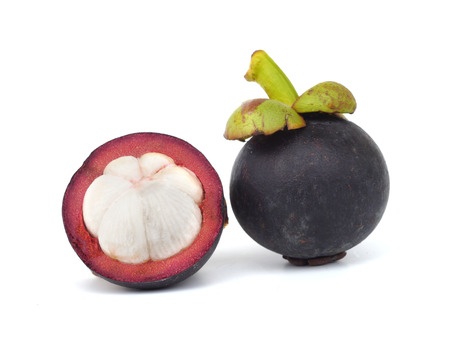Garcinia - Garcinia cambogia

Common Names: Garcinia, Garcinia gummi-gutta, brindleberry, Malabar tamarind, kudam puli, gummiguttrae, geelhars, gamboge, brindal berry, gummigutt tree, garcinia tree, mangoustanier du Cambodge, gomme-gutte, upage mara, murugana huli, garushinia kanbogia, camboge tree
Latin Name: Garcinia cambogia
Origin: Africa, Asia
Short Introduction
Garcinia thrives primarily in moist rainforests as is typical for members of the Clusiaceae family. The plant is cultivated for its fruit. Its shape resembles a yellow, green, or reddish pumpkin, with a thin outer skin and segmented lobes. The fruit color may vary, and when stored or prepared for export, the rind darkens to brown or almost black. The fruit is about the size of an orange or grapefruit. Trees grown from seed begin bearing fruit in 10–12 years; those propagated from cuttings mature and fruit at about 12–15 years. In India, ripe yellow fruit is either collected after falling naturally or manually picked from trees. The skin is removed immediately after harvesting. The plant tends to flower in the dry season. Seeds are mainly dispersed by wind, but also by insects or animal species such as monkeys, squirrels, and other mammals living in the tree canopy that consume the fruit. Garcinia is adapted to both mountainous and lowland environments but particularly favors riverbanks and fertile valleys, as well as regions with intermittently dry soils that are occasionally moistened or flooded. Optimal growth temperature ranges from 15–30°C. In central Europe, including the Czech Republic, cultivating Garcinia without a controlled environment is very challenging. There are currently no registered growers or businesses specifically cultivating Garcinia. The tree prefers shaded locations or shelter and is often interplanted on farms with other crops like ginger and various trees.
Detailed Description
Garcinia is a natural aid for weight loss, fat burning, and dietary reduction—gaining increasing attention for its supportive effects.
Botanical Information
Garcinia is an evergreen, monoecious tree or shrub, either small or of medium height, typically reaching 5 to 20 meters. It boasts a rounded crown with pendulous or horizontally oriented branches. Its dark, smooth bark is complemented by opposite, lanceolate to elliptical leaves that are dark green, glossy, and around 5–10 cm long with short stalks. The inflorescence is a cluster of 5–20 small flowers; individual flowers are mostly red but can appear yellow. Female flowers are found alone or in groups of up to four. Neither the male nor female flowers produce nectar. The fruit is a green berry, about 5 cm in diameter with 6–8 longitudinal grooves, turning yellow or red when ripe. The flesh is succulent and pleasantly flavored.
Origin and Distribution
This tropical plant originates in Indonesia. It is now cultivated across Southeast Asia, inland India, and parts of western to northern Africa for its fruit. Garcinia is abundantly found in evergreen or semi-evergreen tropical forests—especially in western Indian regions like the Ghats, Karnataka, and Kerala. In India, it is widely known as Malabar tamarind. Garcinia may also be available on the market in dried or powdered forms.
Usage / Dosage
Recently, Garcinia has gained popularity as a dietary supplement for weight management and the reduction of overweight and obesity. Its compounds, observed in tissue cultures, inhibit the formation of free fatty acids and also act to suppress appetite. However, it is important to combine its use with at least minimal physical activity and stress management for best results. Preliminary studies show that Garcinia can lower plasma sugar levels and overall peripheral cholesterol—though the exact mechanisms remain under study. The fruit contains a valuable compound, hydroxycitric acid (HCA), which is believed to increase fat burning and curb appetite. HCA likely inhibits the enzyme citrate lyase, responsible for accumulating free fatty acids. Additionally, hydroxycitric acid may raise synaptic serotonin levels in the brain, promoting a feeling of well-being and reducing the urge to eat emotionally.
Animal studies suggest Garcinia’s active ingredients contribute to improved glucose metabolism and storage, so glucose is more readily broken down for energy instead of being stored as fat. However, patients with diabetes using medication should be cautious, as combining therapy with Garcinia may unpredictably lower blood sugar to hypoglycemic levels!
Research also demonstrates Garcinia’s ability to inhibit fat formation from peripheral sugars in favor of muscle or liver glycogen, enhance fat breakdown, and boost thermogenesis, leading to greater energy expenditure from stored sugars. Studies further suggest it can lower total and LDL cholesterol, stabilize cholesterol fluctuations, and potentially increase beneficial HDL cholesterol. If prescribed cholesterol-lowering medication, discontinuing Garcinia use is recommended due to unknown interactions. For those not on such medication, it can be a natural way to reduce ‘bad’ cholesterol and free fatty acids.
In traditional folk medicine, a decoction of the peeled fruit rind is used to alleviate symptoms of rheumatism and treat intestinal disorders (especially those caused by protozoa). For centuries, Garcinia has served as both a spice and an agent to promote a feeling of fullness throughout Asia. Many cultures recommend it to control appetite and as a weight management supplement. The sweet-and-tart fruit pulp is rich in vitamin C and calcium. Garcinia fruit decoction is traditionally used as a mouthwash for canker sores and minor oral inflammations.
Active Compounds
The most prominent active ingredient in Garcinia is hydroxycitric acid (HCA) or its sodium/calcium salts, which exist in both free (bioactive) and lactone forms. The plant also contains significant amounts of calcium and vitamin C, as well as compounds such as cambogin and cambogino.
Traditional Dosage
For capsules: take 1,000–1,500 mg of Garcinia extract three times daily, at least 30 minutes before meals, for several months. For herbal preparations containing dried or powdered fruit, use one teaspoon per 150 ml cup—simply steep in hot water, optionally with milk, sweetened to taste. Drink 2–3 times daily, following the same regime as capsules or other Garcinia products. Traditional daily ‘Garcinia coffee’ dosage: three cups a day, half an hour before lunch and dinner.
